After the Virgin Mary, St. Francis of Assisi is probably Catholicism’s most popular saint. Sure, other saints do more practical things: St. Anthony can help you find lost car keys, and St. Joseph can help you sell your house. St. Sebastian stuck full of arrows, shaggy wild man John the Baptist, or a barely clothed Mary Magdalene might be the most visually interesting.
But can anyone really match the array of settings in which we find the Poor Man of Assisi? Name another saint whose likeness exists in media as varied as frescos, film, graphic novels, and urns for cremated pet remains. Every diocese has a parish named for him. Any museum with a medieval art collection has a St. Francis tucked away somewhere. Several saints may have hospitals named after them, but Francis is likely the only one to be the patron of hospitals for both humans and animals. Francis’ Italian hometown draws tourists and world leaders. In the United States San Francisco is named for him. Further down the California coast the city of Nuestra Senora de los Angeles de la Porciuncula is named for the first Franciscan church and the place where Francis died in 1226. That, however, is a lot to fit on city letterhead, so for simplicity’s sake we call it Los Angeles.
When I teach History 101 to college freshmen, St. Francis of Assisi has a starring role in our lecture about medieval religious life. His costar is the lesser-known religious reformer, Peter Waldo.
The outlines of the two men’s lives are remarkably similar. Both were born in the 12th century, about a generation apart. Waldo was French; Francis was Italian. Each was a wealthy cloth merchant. As young professionals, both men had spiritual epiphanies that prompted them to renounce all their possessions. Taking as their lodestar the poverty and simplicity of Christ, each preached a message that was sharply at odds with the opulence and arcana of medieval liturgy. Each man’s ministry faced scrutiny from church authorities leery of religious upstarts.
Francis went on to found a successful religious order. Waldo was excommunicated, several of his followers were executed, and the exact circumstances of his death are a matter of historical speculation. For two men with such similar origins and messages, what caused their paths to diverge so dramatically?
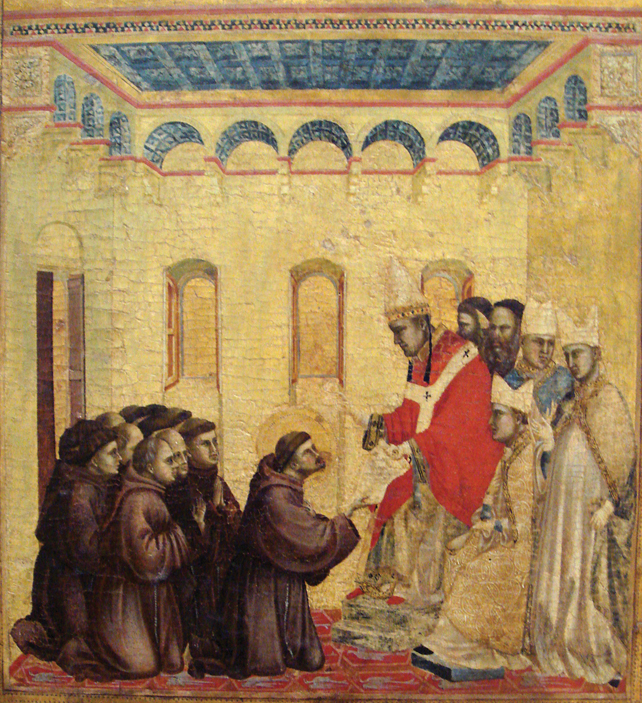
After a moment of fidgety silence my students begin to tease out an answer: Francis actively sought official church sanction for his preaching, and he received it after the pope had a dream in which a superhuman Francis held up a collapsing church roof. Waldo, in contrast, was wary of allowing church hierarchy to interfere with his ministry. “So,” one student tentatively interjected, “We say he’s great, but really, St. Francis of Assisi is kind of a sellout.”
Today Francis’ journey to seek papal permission to found a new religious order is depicted in a giant fascist-era statue outside Rome’s Basilica of St. John Lateran. Commissioned to celebrate the 700th anniversary of Francis’ death, it was installed a year late, in 1927; the trains may have run on time in Mussolini’s Italy, but sculptor Giuseppe Tonnini would not be rushed. For the fascists, though, it hardly mattered. They swathed their rise to power in Franciscan imagery. Francis embraced poverty and self-sacrifice, just as all Italians living within the fascist state were expected to do. More importantly, Francis was Italian. His Italian preaching blazed a path for vernacular giants like Dante and Petrarch. The Fascist government pointed out that during Francis’ lifetime he stood up to the corrupting, internationalist designs of the Holy Roman Emperor, a brave and truly Italian model the fascists would follow as they stood up to the corrupting, internationalist designs of communism. To drive the message home, the fascists spent a considerable amount of money restoring medieval Assisi as a fitting shrine for a national hero.
Sellout and fascist mascot are hard to square with Francis’ better-known iterations. As Patricia Appelbaum argues in her book St. Francis of America (The University of North Carolina Press), St. Francis’ trip from medieval Assisi to the brown-robed, bearded figure who presides over gardens and pet blessings like a saintly Obi-Wan Kenobi has been a winding one. In the United States, the popularization of this Catholic saint, in particular his peaceful, gentle version, owes a heavy debt to mainline American Protestantism.
According to Appelbaum, “Nineteenth-century Protestants rediscovered Francis through the genteel, cultivated channels of art, continental travel, and historical studies. They accepted him as a true follower of Jesus and a proto-Protestant harbinger of freedom.” During the 19th century, renewed interest in Francis was also part of a renewed interest in medieval history. In contrast to American industrialization and urbanization, the Middle Ages were thought to be a purer, more authentic time. Within this vision of history, Francis was authenticity squared—a figure from a simpler, more authentic time who spent his career calling his peers to a simpler, more authentically Christian life.
St. Francis, the patron saint of animals
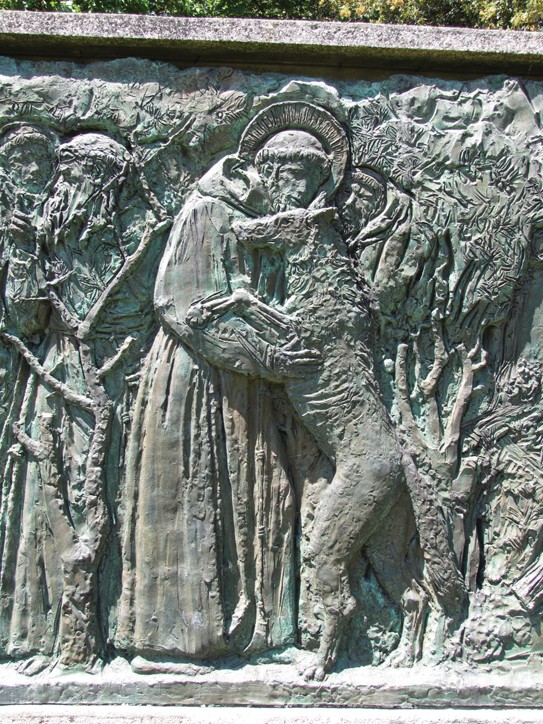 Still, there were plenty of medieval saints who could have scratched the authenticity itch. St. Dominic, whose life overlaps nearly exactly with St. Francis’, preached and embraced poverty, selling his furniture and even his beloved books to assist famine victims. Unfortunately, by the 19th century the Dominicans’ involvement with the Inquisition cast Dominic as a villain in the Protestant imagination. St. Clare of Assisi was one of Francis’ earliest followers, espousing the same simplicity and poverty Francis did. As a cloistered woman, though, she didn’t get out much. Francis’ very public embrace of poverty probably contributed to his popularity. The feature of his life that likely cemented his place in the late-19th and early-20th century religious imagination, though, was his love of animals.
Still, there were plenty of medieval saints who could have scratched the authenticity itch. St. Dominic, whose life overlaps nearly exactly with St. Francis’, preached and embraced poverty, selling his furniture and even his beloved books to assist famine victims. Unfortunately, by the 19th century the Dominicans’ involvement with the Inquisition cast Dominic as a villain in the Protestant imagination. St. Clare of Assisi was one of Francis’ earliest followers, espousing the same simplicity and poverty Francis did. As a cloistered woman, though, she didn’t get out much. Francis’ very public embrace of poverty probably contributed to his popularity. The feature of his life that likely cemented his place in the late-19th and early-20th century religious imagination, though, was his love of animals.
Arguably the most iconic demonstration of this love was Francis’ interactions with birds. When asked why the birds seem to be the animal most associated with Francis, Appelbaum speculates that the famous fresco of Francis preaching to birds in the basilica in Assisi should get much of the credit. Still, she notes other sources deserve credit, as well. “We have the sermon to the birds, that may be part of the reason. There are actually a couple stories about him talking to birds and preaching to them, or telling the birds to be quiet while he preached his sermon to everyone else,” she says. In American iconography, birds have pride of place. By the midcentury, advertisements from Home and Garden magazine and the Sears catalogs offered Francis statues for sale with birds nestled in his arms or gathered at his feet. “Certainly in the 20th century, the [birds] imagery wins out,” says Appelbaum.
Thomas of Celano, a fellow Franciscan and one of St. Francis’ earliest biographers, is a source not just for the bird stories, but many more encounters between Francis and animals. There were at least two occasions when Francis freed hares caught in traps. Once, while sitting on a lakeshore near the town of Rieti, a fisherman brought Francis a particularly large fish. Francis embraced the fish as his brother, placed it back in the water, and began to preach. The fish waited patiently for Francis to finish his sermon before swimming away.
Still, Francis’ love for animals had its limits. He had no patience for mice or flies. When he cursed a pig who trampled a lamb, the pig immediately became ill and died a few days later. Francis also ate meat and was reportedly fond of fish in particular, so what let the fish of Rieti off the hook remains a mystery.
It is Francis’ interaction with another animal, however, that cemented his reputation not just as a simple, loving soul, but as an active peacemaker. The details vary from source to source, but according to legend, Francis negotiated a peace between the townspeople of Gubbio, in central Italy, and a wolf that had been killing livestock and townspeople. Other saintly stories from the Middle Ages involve saints persuading wolves to move on after villagers do penance. The wolf of Gubbio is remarkable because, with Francis’ mediation, the wolf becomes a member of the community, with the people agreeing to provide it food and shelter for the rest of its life. Today visitors to Gubbio can visit two churches dedicated to this miracle: San Francesco della Pace, built on the site of the wolf’s home, and Santa Maria della Vittoria, where the wolf and the townspeople concluded their pact.
St. Francis, the peace prayer saint
The most famous expression of Franciscan peacemaking is not a depiction of the wolf. Rather it is the “Prayer of St. Francis,” or the “Peace Prayer.” Appelbaum notes that this prayer is recorded nowhere in Franciscan sources, instead first appearing in a French Catholic magazine in 1913 and printed in Italian by a Vatican magazine in 1916. The prayer was largely popularized in the English-speaking world by Protestants and gained popularity during the dark days of world war, economic depression, and uneasy peace that loomed over the first half of the 20th century.
Appelbaum points out that despite this charged context the prayer’s call to peacemaking is deeply personal. “It emphasizes personal transformation as a way to peace: seeking to understand, to love. For peace activists, these emphases were quite consistent with the turn toward spiritually based nonviolent action. For others, they set the prayer free from political implications. Giving, pardoning, and dying into eternal life are all personal concerns,” she says. The attribution to Francis, though, certainly didn’t hurt the prayer’s popularity. “It gives it a certain bit of cachet, and people who know Francis didn’t really write it still love the prayer,” Appelbaum says.
The belief that peace and peacemaking begin with the individual were visible throughout Chicago this past summer. Each of the archdiocese’s 217 schools displayed a banner announcing, “We are praying for a peaceful summer. Join us.” This year’s “Prayer for a Peaceful Summer” campaign kicked off on May 23 when, at 1:30 in the afternoon, all of Chicago’s 76,000 Catholic school students prayed the Prayer of St. Francis.
According to Jim Rigg, superintendent for Catholic Schools for the Archdiocese of Chicago, “Violence is a tragedy that impacts many families in our region. . . . We chose the Prayer of St. Francis because it calls us to become ‘instruments’ of God’s peace. True peace begins within each of us, and every person has a responsibility to spread God’s peace through word, action, and prayer. The Prayer of St. Francis encourages each of us to examine our own hearts, and calls us to foster peace to those around us.” Rigg himself spent the day praying with elementary school students who had been affected by violence in Chicago’s Brighton Park neighborhood.
For the students, learning from this Franciscan example is not a one-time event. Rigg says, “Last fall we began formulating a specific anti-bias program that will be engrained within our curricula in several areas. This new program will enable students to examine how they can combat hatred, racism, and bias in their own lives.”
Francis, the Jesuit from Argentina
When asked what sparked her interest in St. Francis, Appelbaum describes encountering a Francis similar to the one who bedeviled my students. “I grew up in Quakerism, which doesn’t deal with saints at all and yet everybody knows about St. Francis, talking about him and looking to his stories and looking to him as an example. It wasn’t the same type of devotion you would see in a Catholic community, but certainly sharing the stories and looking to him as a Christian model was quite common,” she says. Studying Francis in graduate school changed her perspective. “I had to read some of the writings that are attributed to Francis, with greater or lesser certainty. And it wasn’t the guy with the birds anymore; it wasn’t the nice guy who lived peacefully and adopted voluntary simplicity. All that is there, but there is also all this material about respecting priests and honoring the pope and receiving the Eucharist and suffering and sacrifice and none of this was in the St. Francis I knew about,” Appelbaum says.
From his lifetime to the present day, people have seemed to look to Francis to find something true and something authentic. They seem a little disappointed when the details don’t always add up.
Historically speaking, we have only the roughest outline of his life—birth and death, conversion, foundation, and canonization, plus a hearty dose of flora and fauna—so is there really an authentic St. Francis to betray? Even his famous name is not exactly his own. His mother had him baptized as Giovanni. His father, who was away at the time, returned home and promptly renamed the boy Francesco, or “Frenchie,” possibly to commemorate the successful business trip to France that caused him to miss his son’s baptism.
Given the jumble of misattributions, legends, and contradictions that litter the path of those trying to find an “authentic” St. Francis, it is perhaps fitting that the 21st century’s highest-profile “Franciscan” is a Jesuit from Argentina.
According to his own recollection, Jorge Mario Bergoglio chose the name Francis after a fellow cardinal reminded him “Don’t forget the poor,” though it seems unlikely that he would. As archbishop of Buenos Aires, Francis refused to live in the episcopal palace and took public transportation to his engagements. He wore his predecessor’s hand-me-down vestments to his elevation as cardinal, and his pontificate has been distinguished by visits to housing projects, prisons, and squatters’ camps.
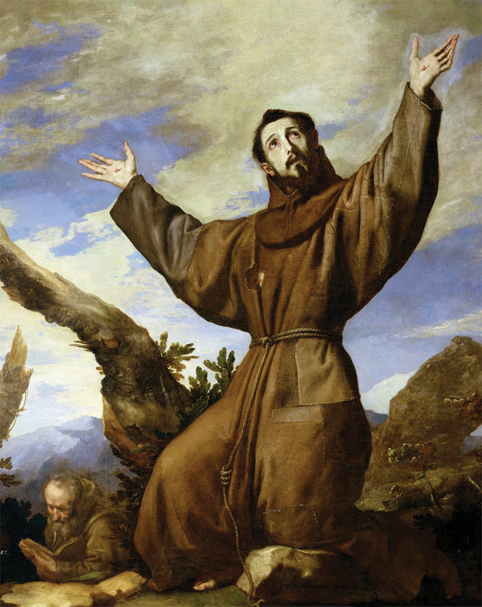 The Franciscan appellation, though, cuts both ways. Future students may have to reconcile the “cool pope” who welcomed nursing mothers to the Sistine Chapel and made a sandwich for a tired Swiss Guard with the head of the Argentine Jesuits who pushed more theologically innovative professors out of university teaching jobs and pressured other colleagues to pseudonymously publish abroad so the Jesuits did not draw attention from the military junta.
The Franciscan appellation, though, cuts both ways. Future students may have to reconcile the “cool pope” who welcomed nursing mothers to the Sistine Chapel and made a sandwich for a tired Swiss Guard with the head of the Argentine Jesuits who pushed more theologically innovative professors out of university teaching jobs and pressured other colleagues to pseudonymously publish abroad so the Jesuits did not draw attention from the military junta.
Ironically, emulating the example of St. Francis might be one of Pope Francis’ most Jesuit qualities. Discussing how to discern the best path for one’s life, a hallmark of Jesuit spirituality, St. Ignatius Loyola suggests imagining oneself living the life of a saint you particularly admire. In the Spiritual Exercises, he writes, “How would it be if I did this which St. Francis did? . . . St. Francis did this, so must I do it.”
Pope Francis seems to be constantly finding new ways to follow this suggestion. In June 2015 Francis became the first pope to visit a Waldensian church. At the Waldensian temple in Turin, he implored the spiritual descendants of Peter Waldo to forgive “the non-Christian, or even non-human, attitudes and behaviors that we historically have held toward you. In the name of the Lord Jesus Christ, forgive us.”
St. Francis likely couldn’t have said it better.
This article also appears in the October 2017 issue of U.S. Catholic (Vol. 82, No. 10, pages 12–17).
Images (from top to bottom): Giotto di Bondone (1297–1299); Giotto, Legend of St. Francis (1295–1300), Louvre Museum via Wikimedia Commons; Flickr.com/Christopher John, SSF; El Greco; Jusepe de Ribera, St. Francis of Assisi (1642), El Escorial via Wikimedia Commons




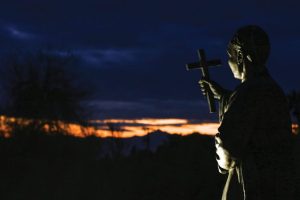
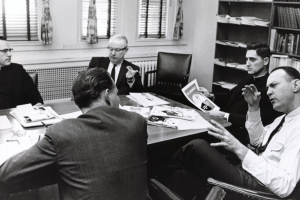
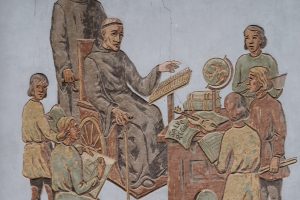







Add comment